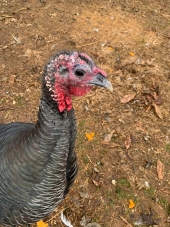
 1
1




Blog: 5 Acres & A Dream
Books: Kikobian Books | Permies Digital Market
 1
1




Best luck: satisfaction
Greatest curse, greed
 2
2




Sara Carver FNP-C, Florida Homesteader, Chicken and Turkey Lover, Novel Herbalist and Permie
 2
2




 1
1




Leigh Tate wrote:This is our first year with turkeys. We got them as poults back in June, so they are about 8 months old. Trouble is, they're still young, so we don't know which are male and which are female. We kinda thought they would be changing enough by this time to distinguish their sexes, but they all look the same. Maybe they are all the same? So far, no eggs and no gobbling (but it's still winter, so maybe that's why).
Most articles on turkeys talk about sexing them as poults, which we didn't do. But trying to find information on sexing grown turkeys hasn't been easy. Searching "sex adult turkeys" returns results that have nothing to do with poultry.
Any turkey experts out there with some guidance?
Education: "the ardent search for truth and its unselfish transmission to youth and to all those learning to think rigorously, so as to act rightly and to serve humanity better." - John Paul II




Thomas Dean wrote:Any more photos? Again, those three are all likely hens.
Blog: 5 Acres & A Dream
Books: Kikobian Books | Permies Digital Market
 2
2




 I've raised turkeys for decades so can give a few tips for sexing older poults/adults. Females have feathers farther up their neck and just the head is bare, while males' necks are basically bare (a few stray feathers) before adulthood. Males necks, heads and wattles turn brighter colours than females, and their snood (the little dangly bit above the beak) elongates when they're excited. Some breeds of turkey females grow beards frequently. I've had a couple with longer beards than the toms. Males always grow spurs, but it's rare for a female to. Females make different sounds, sort of like "yulp yulp". Young birds, both male and female will display and dance, and even the odd adult female will but their tails aren't as wide and are usually longer and narrower at the base than males'.
I've raised turkeys for decades so can give a few tips for sexing older poults/adults. Females have feathers farther up their neck and just the head is bare, while males' necks are basically bare (a few stray feathers) before adulthood. Males necks, heads and wattles turn brighter colours than females, and their snood (the little dangly bit above the beak) elongates when they're excited. Some breeds of turkey females grow beards frequently. I've had a couple with longer beards than the toms. Males always grow spurs, but it's rare for a female to. Females make different sounds, sort of like "yulp yulp". Young birds, both male and female will display and dance, and even the odd adult female will but their tails aren't as wide and are usually longer and narrower at the base than males'.
 1
1








Blog: 5 Acres & A Dream
Books: Kikobian Books | Permies Digital Market

|
Message for you sir! I think it is a tiny ad:
The new purple deck of permaculture playing cards
https://www.kickstarter.com/projects/paulwheaton/garden-cards
|





